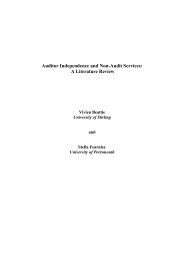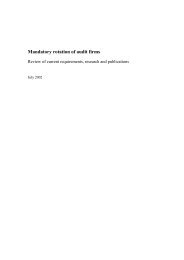In this <strong>in</strong>stance, while national security was considered to carry significant weight<strong>in</strong>g, this wasnot considered an excuse to avoid mitigation of <strong>the</strong> effect.An <strong>in</strong>ternational study on particular medical treatments considered criteria <strong>for</strong> patient selection. 193It found that social value criteria were widely applied. The actual weight<strong>in</strong>gs were largely <strong>the</strong>product of <strong>the</strong> beliefs of <strong>in</strong>dividual doctors, although cl<strong>in</strong>ical criteria were provided by someprofessional bodies. Ano<strong>the</strong>r medical study of 450 dialysis and transplant doctors was able todeterm<strong>in</strong>e a set of weight<strong>in</strong>gs actually applied. They range from medical benefit, with a weight<strong>in</strong>gof 4.2, through, <strong>for</strong> example, will<strong>in</strong>gness – 3.7, age – 2.7, and ability to pay – 1.8, to gender –1.0. 194 Many of <strong>the</strong> aspects considered are clearly removed from broadly based impact criteriaand social value criteria can be seen as arbitrary and unfair. 195 Not least of <strong>the</strong> controversy iswhe<strong>the</strong>r <strong>the</strong> decisions should be left to specialists or take <strong>in</strong>to consideration wider <strong>public</strong> views.Sometimes <strong>the</strong>re are absolute values that are so important (<strong>for</strong> example basic human rights)that <strong>the</strong>y need to prevail <strong>in</strong> all but <strong>the</strong> most extreme situations. These can be dealt with by,<strong>in</strong> effect, apply<strong>in</strong>g a weight<strong>in</strong>g of 100% or near to it.8.2.6 Trade-off of <strong>in</strong>terestsGiven conflicts between <strong>the</strong> <strong>in</strong>terests of different elements of <strong>the</strong> relevant <strong>public</strong>, <strong>the</strong> issuearises of whe<strong>the</strong>r it is right and proper to benefit one section of <strong>the</strong> community at <strong>the</strong> expenseof ano<strong>the</strong>r: <strong>in</strong> economic terms, what is maximis<strong>in</strong>g <strong>the</strong> end result considered to mean?One measure, known as Pareto efficiency, takes it that output is maximised when it wouldbe impossible to make someone better off, without mak<strong>in</strong>g someone else worse off. Welfareeconomics, which considers distributive economic efficiency, often regards Pareto efficiencyas <strong>the</strong> appropriate measure. In perfectly competitive markets <strong>the</strong>re will be a set of prices atwhich aggregate demand equals aggregate supply <strong>for</strong> each commodity. This is competitiveequilibrium. The key pr<strong>in</strong>ciples of welfare economics are that:• every competitive equilibrium is Pareto efficient; and• every Pareto efficient outcome can be achieved by an appropriate allocation of resources.Extend<strong>in</strong>g <strong>the</strong> logic, every Pareto efficient allocation can be changed by reallocationbetween <strong>the</strong> parties <strong>in</strong>volved. 196However, this takes no account of <strong>the</strong> distribution issues that arise if consideration is be<strong>in</strong>ggiven to <strong>in</strong>terfer<strong>in</strong>g with <strong>the</strong> market equilibrium po<strong>in</strong>t <strong>in</strong> order to move to a different po<strong>in</strong>ton an output curve, or a po<strong>in</strong>t on a different curve.Panel 8.4: Pareto allocationConsider an example of possible utility outcomes <strong>for</strong> various parts of a society: 197BCAThe axes show <strong>in</strong>creas<strong>in</strong>g amounts of utility achieved by two different sections of society, <strong>for</strong>different outcomes.Position A represents <strong>the</strong> utility outcome achieved under market equilibrium. However,because of some sort of market failure, government <strong>in</strong>terference to correct that failure couldachieve positions B or C. Both B and C are on higher utility outcome curves than A so bothwould be an advance <strong>in</strong> terms of overall utility, but which, if ei<strong>the</strong>r, is a success?B is on a higher Pareto curve than C so <strong>in</strong> Pareto terms B would be a welfare success and C awelfare failure. However, <strong>in</strong> <strong>the</strong> absence of offsett<strong>in</strong>g transfers (which is a political option), toget from A to B, <strong>the</strong> much higher utility of one section is offset by a small reduction <strong>in</strong> utility<strong>in</strong> ano<strong>the</strong>r section. There is an argument that <strong>in</strong> economic terms, government <strong>in</strong>tervention islegitimate only if <strong>the</strong> position achieved through <strong>in</strong>terference is better, or at least no worse, <strong>in</strong>every way. This would <strong>the</strong> case with outcome C, which marks an improvement <strong>in</strong> utility <strong>for</strong>all sections, but B would be regarded as a failure <strong>in</strong> <strong>the</strong>se terms.193Quoted <strong>in</strong> Pleasence and Maclean, ‘The Public Interest’.194Quoted <strong>in</strong> Pleasence and Maclean, ibid.195Pleasence and Maclean, ibid.196Kay, The Truth About Markets, Besley, Welfare Economics and Public Choice.197Based on Besley, ibid.58Aggregation and decision
One way of deal<strong>in</strong>g with a position <strong>in</strong> which <strong>the</strong>re is a loss to one set of people <strong>in</strong> order tobenefit ano<strong>the</strong>r, would be to arrange offsett<strong>in</strong>g payments, <strong>for</strong> example a lump sum to offset lossof future benefits. Ano<strong>the</strong>r way would be to settle <strong>for</strong> an alternative outcome where everyone isat least no worse off even if it is, <strong>in</strong> some terms, <strong>the</strong>oretically sub optimal to ano<strong>the</strong>r outcome.This is position C <strong>in</strong> Panel 8.4. A third way is to conclude that <strong>the</strong> <strong>in</strong>terests of <strong>the</strong> section be<strong>in</strong>gbenefited are more important, <strong>in</strong> this respect at least, than those of <strong>the</strong> disadvantaged section.An example of this is welfare payments to <strong>the</strong> poor, funded by taxation on <strong>in</strong>comes of thosebetter off. This <strong>in</strong>volves weight<strong>in</strong>g of <strong>in</strong>terests.Whatever method is used, this is likely to be a key consideration <strong>in</strong> assessment by o<strong>the</strong>rs as towhe<strong>the</strong>r <strong>the</strong> action really is <strong>in</strong>tended to be <strong>in</strong> <strong>the</strong> <strong>public</strong> <strong>in</strong>terest or is more of a smokescreen,hav<strong>in</strong>g been subject to undue <strong>in</strong>fluence. Transparency is particularly important here. This is notto say that <strong>the</strong> process of <strong>the</strong> decision should take precedent over <strong>the</strong> outcome: while <strong>the</strong>re maybe pragmatic issues that result <strong>in</strong> a less than optimal outcome, that substandard outcome can hardlybe justified as be<strong>in</strong>g <strong>in</strong> <strong>the</strong> <strong>public</strong> <strong>in</strong>terest if it is caused by prioritis<strong>in</strong>g appearance over all else.Given <strong>the</strong> tendency to concentrate on expressed <strong>in</strong>terest (discussed above) use of <strong>public</strong> vot<strong>in</strong>gand or generally supported custom and law can be safer options. 1988.3 Practical ways <strong>for</strong>wardMeasurement is <strong>the</strong>oretically simple, but <strong>in</strong> practice sensible numbers are difficulty to come by.Weight<strong>in</strong>g is possible and <strong>in</strong>deed has to be done. However, it is fraught with difficulty. How,<strong>the</strong>re<strong>for</strong>e, do those advocat<strong>in</strong>g <strong>public</strong> <strong>in</strong>terest positions actually determ<strong>in</strong>e whose <strong>in</strong>terests areto be considered and how to deal with conflicts?One option is to determ<strong>in</strong>e that <strong>the</strong>re is a ‘w<strong>in</strong>–w<strong>in</strong>’ situation: everyone is better off or at leastsome are better off and no-one is harmed. As noted <strong>in</strong> <strong>the</strong> discussion <strong>in</strong> Panel 8.4 on Paretoefficiency, this can arrive at a quite different solution to one <strong>in</strong> which <strong>the</strong>re are w<strong>in</strong>ners and losers.Given <strong>the</strong> wide divergence of op<strong>in</strong>ions and circumstances, <strong>the</strong>re is seldom an agreed view that<strong>the</strong>re has been a w<strong>in</strong>-w<strong>in</strong> anyway, or even if it is, that <strong>the</strong> allocation of ‘w<strong>in</strong>’ is fair and reasonable.However, divergent views can be taken advantage of to achieve this: if <strong>the</strong>re are differentexpectations as to what will happen, it may be possible to construct an arrangement where allparties th<strong>in</strong>k <strong>the</strong>y will w<strong>in</strong>, 199 <strong>for</strong> example fix<strong>in</strong>g upper and lower limits on a price (a cap andcollar arrangement), where <strong>the</strong> parties both regard <strong>the</strong> pric<strong>in</strong>g as <strong>in</strong> <strong>the</strong>ir <strong>in</strong>terests, due todifferent expectations as to volume.Where <strong>the</strong>re are positive and negative attributes to be considered, as is usually <strong>the</strong> case withsocial decision mak<strong>in</strong>g, impact <strong>analysis</strong> is a useful means of assess<strong>in</strong>g <strong>the</strong> net effect. It alsoassists <strong>in</strong> demonstrat<strong>in</strong>g <strong>the</strong> decision taken.One suggestion made, as a means of comb<strong>in</strong><strong>in</strong>g <strong>the</strong> best parts of all approaches, is <strong>the</strong> use of‘<strong>in</strong><strong>for</strong>med <strong>in</strong>tuition’. 200 This, <strong>in</strong> essence, takes aspects of <strong>the</strong> Bazerman approach – assess <strong>the</strong>problem, consider <strong>the</strong> goals and <strong>the</strong>ir importance, consider what actions would facilitate whatgoals – and <strong>the</strong>n make an <strong>in</strong>tuitive judgement, monitor<strong>in</strong>g your emotional reaction to differentoptions. It can also be applied <strong>the</strong> o<strong>the</strong>r way around – as noted above it is difficult to switchoff <strong>in</strong>tuition, so <strong>the</strong> rational calculation process can be used to act as a logic check on what<strong>in</strong>tuition has suggested <strong>in</strong> <strong>the</strong> first place.This approach is perhaps of more value to <strong>in</strong>dividuals than regulators or o<strong>the</strong>r accountableorganisations although even <strong>in</strong> <strong>the</strong> latter it <strong>in</strong>dicates that ‘gut feel’ can be valuable if it can bejustified as not be<strong>in</strong>g subverted by <strong>in</strong>appropriate <strong>in</strong>fluences.8.4 Chapter summaryThe advocate of a <strong>public</strong> <strong>in</strong>terest action needs to apply, and be seen to be apply, judgementto <strong>in</strong><strong>for</strong>mation ga<strong>the</strong>red about <strong>in</strong>dividual wants, needs and o<strong>the</strong>r constra<strong>in</strong>ts to wants. Theremay be a series of measurement issues to overcome, <strong>in</strong>clud<strong>in</strong>g: quantification; <strong>in</strong>teraction;weight<strong>in</strong>g; and how to maximise <strong>the</strong> end result when <strong>the</strong>re may be several acceptable solutions.A logical approach is needed to determ<strong>in</strong>e what outcome would be <strong>in</strong> <strong>the</strong> <strong>public</strong> <strong>in</strong>terest, or <strong>in</strong> <strong>the</strong>case of multiple positive outcomes, most <strong>in</strong> <strong>the</strong> <strong>public</strong> <strong>in</strong>terest. A decision based on a rationalbasis of calculation will assist transparency but is easier said than done. Use of <strong>in</strong><strong>for</strong>med <strong>in</strong>tuitionand impact <strong>analysis</strong> may be relevant, although this will at least partially depend on <strong>the</strong> natureof <strong>the</strong> advocate.198Desk<strong>in</strong>s, ‘On <strong>the</strong> Nature of <strong>the</strong> Public Interest’.199Brandenburger and Nalebuff, ‘The Right Game: Use Game Theory to Shape Strategy’.200Thagard, How to Make Decisions: Coherence, Emotion and Practical Inference.Aggregation and decision59
















